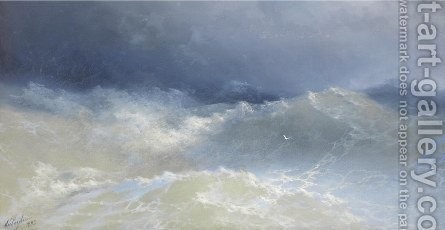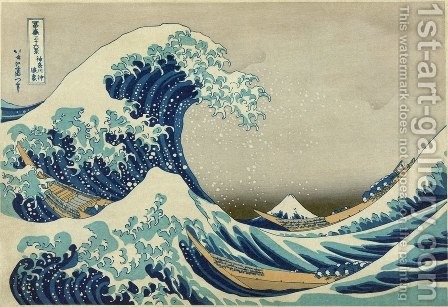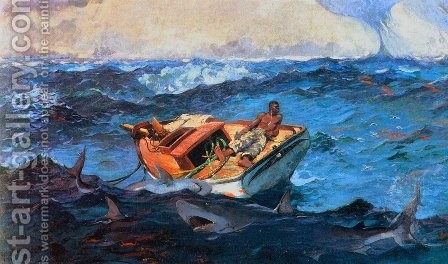Ocean and oceanic voyages are popular genres of art and find their root from the very beginning of art history. The earliest examples of oceanic art can be seen on the Egyptian pottery works, Assyrian reliefs, and even on the Chinese porcelains.
Oceans in art paintings are absolutely amazing – they have the ability to expand your horizon, vision, and thinking capacities. While its calm face soothes your mind, the crashing of the waves sets your pulses racing and your heart thumping. Moreover, artists who faithfully paint the numerous moods of the ocean never fail to earn appreciation from the audience.
Below, we have curated a list of some of the painting masterpieces in the ocean art genre. Through their arts, artists were able to create powerful visualizations that paid homage to the beauty of the ocean and at the same time showcased the devastating impact on oceans caused by human deeds.
Among the Waves – Ivan Konstantinovich Aivazovsky
Ivan Aivazovsky is known for painting some of the most famous and dramatic seascape paintings of all time. A number of his paintings like The Bay of Naples, Hurricane at the Sea, and Rainbow show the ocean in its various shades, but “Among the Waves” painted in 1898 remains to be the most famous ocean painting of the artist to date.
The master-marine painter created this masterpiece when he had already crossed the eighty-year mark. The picture is literally saturated with moisture and feels like it is going beyond the small boundaries of the canvas. In the picture, Ivan incredibly portrayed the angry sea element. We can see a full-fledged storm, a raging sea, strong waves bubbling and boiling, and all set to absorb lives nearby it.
The reproduced works do not have a boat with shipwrecked victims, which according to Aivazovsky’s grandson was present in the original painting.
The Great Wave off Kanagawa – Katsushika Hokusai
Japanese painters have always provided us with a different and mystical vision of the natural phenomena like this masterpiece called “The Great Wave off Kanagawa” crafted by Japanese painter Katsushika Hokusai.
Also referred to as “Under the Wave off Kanagawa,” this artwork is a part of a series of prints titled Thirty-Six Views of Mount Fuji” which was painted by the artist between 1830 and 1833. All of the images in the series feature a glimpse of Mount Fuji, but this particular painting focuses on the enormous wave in the foreground that almost looks like a monster with huge claws.
The threatening waves are captured just moments before it is about to swallow three fishing boats underneath it. The terrible ocean’s claw looks so ferocious that it even seems to be threatening to devour the sacred Mount Fuji which is presented in the background, as another victim of the evil wave.
The Gulf Stream – Winslow Homer
Winslow Homer was quite preoccupied with the might of the ocean which he often made the subject of his paintings. “The Gulf Stream” is one of Homer’s great paintings in the genre of ocean painting that he crafted in the last ten years of his life.
The Gulf Stream presents a well-defined fishing boat which is pretty small, rudderless, and without a sail, in a very violent seascape and sky. The fisherman is alone in a boat surrounded by ravenous sharks and high tides on the right-hand background. Even in such a tempting situation, the man seems to be very calm and composed.
Talking about its possible symbolism, the artist might be depicting the hope to somehow make the elements of the world friendly and somehow not fear them as enemies. It is often suggested that the painting also depicts Homer’s understanding and synopsis of his lifetime of experiences which was deepened by adversities.
The Fighting Téméraire – Joseph Mallord William Turner
Joseph Mallord William Turner is probably the most iconic seascape painter of any age and at least two or three artworks of his would have made it to the list. But since we are including only one artwork from an artist, the above-presented creation titled “The Fighting Téméraire” falls on this list. The actual name of the painting is The Fighting Téméraire tugged to her last berth to be broken up and was painted in 1838.
Audacious and technically perfect, the major focus of the painting is the HMS Temeraire, a 98-gun second rate warship of the Royal Navy remembered for its influential role in the Battle of Trafalgar. The painting represents the final journey of the battleship to a London shipyard. In the painting, the gigantic ship appears like a ghost and is being towed by a small, dark, and steam-powered tugboat.
Often symbolized as the end of an era, the end of heroic power, and the advent of the Industrial revolution, the masterpiece is considered to be one of the artist’s personal favorites which he refused to sell during his lifetime.
The Bottom Line
Oceans painting is such an art genre that reflects the depth of your soul and represents a relentless flow of the stream of thoughts. If you also want oceans painting for yourself or your beloved ones, then the 1st Art Gallery is the place you have to visit. https://www.1st-art-gallery.com/Nautical/Ocean-Scenes.html blesses you with the incredible ocean masterpieces that will keep you stunned.




